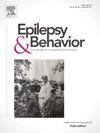德尔菲共识:小儿疑似德拉韦综合征患者的转诊标准
IF 2.3
3区 医学
Q2 BEHAVIORAL SCIENCES
引用次数: 0
摘要
目的本研究旨在以服部先例为基础,建立转诊标准,以帮助一线护理机构轻松识别和转诊疑似Dravet综合征(DS)的儿童患者,以支持早期诊断和适当管理。方法由9名癫痫专家组成的科学委员会(SC)经协商一致审查,制定推荐标准。由10名非癫痫专业的一线卫生保健专业人员组成的专家小组(EP)使用传统的两阶段德尔菲法评估了这些标准的适用性。结果采用调整对称性的百分位间距法进行评估。结果SC提出了4项DS转诊标准,包括:(1)1岁前有长时间发热/非发热性惊厥史;(2) 1岁前不同类型非热性惊厥史;(3) 1岁前对体温变化敏感的癫痫发作史;(4)神经发育障碍,无既往症状或消退。由于缺乏一线专业人员的检测,遗传学标准被排除在外。EP将所有四项标准评为适合一线专业人员使用的标准(A),在四个维度(“易于识别”,“相关性”,“符合一项标准的转诊可行性”和“转诊可行性”)上具有高度共识(中位数得分为6-9);1条标准满足”)。结论在目前的临床实践框架内,已经确定并验证了一套DS转诊标准,供非癫痫专业人员使用。调整后的标准对于纳入现有的护理方案是有效和有益的。本文章由计算机程序翻译,如有差异,请以英文原文为准。
Delphi consensus on referral criteria for pediatric patients with suspected Dravet syndrome
Objectives
This study aimed to establish referral criteria, based on the Hattori precedent, to assist in the easy identification and referral of pediatric patients with suspected Dravet syndrome (DS) at first-line care facilities to support early diagnosis and appropriate management.
Methods
DS referral criteria were developed by a Scientific Committee (SC) of 9 epilepsy specialists by consensus review. These criteria were evaluated for suitability by an Expert Panel (EP) comprising 10 frontline healthcare professionals not specialized in epilepsy using a conventional two-phase Delphi methodology. Results were evaluated using the Interpercentile Range Adjusted for Symmetry method.
Results
Four DS referral criteria were proposed by the SC, including: (1) history of prolonged febrile/non-febrile seizures before one year of age; (2) history of different types of non-febrile seizures before one year of age; (3) history of seizures sensitive to temperature changes before one year of age; and (4) neurodevelopmental disorders without previous signs or regression. Genetic criteria were excluded due to lack of availability of tests for frontline professionals. The EP rated all four criteria as appropriate for use by frontline professionals (A), with a high degree of consensus (median score 6–9) across four dimensions (“ease of identification”, “relevance”, “feasibility of referral if one criterion met”, and “feasibility of referral if > 1 criterion met”).
Conclusions
A set of DS referral criteria has been identified and validated for use by non-epilepsy-specialized professionals within the framework of current clinical practice. The adapted criteria could be effective and beneficial for incorporation into existing care protocols.
求助全文
通过发布文献求助,成功后即可免费获取论文全文。
去求助
来源期刊

Epilepsy & Behavior
医学-行为科学
CiteScore
5.40
自引率
15.40%
发文量
385
审稿时长
43 days
期刊介绍:
Epilepsy & Behavior is the fastest-growing international journal uniquely devoted to the rapid dissemination of the most current information available on the behavioral aspects of seizures and epilepsy.
Epilepsy & Behavior presents original peer-reviewed articles based on laboratory and clinical research. Topics are drawn from a variety of fields, including clinical neurology, neurosurgery, neuropsychiatry, neuropsychology, neurophysiology, neuropharmacology, and neuroimaging.
From September 2012 Epilepsy & Behavior stopped accepting Case Reports for publication in the journal. From this date authors who submit to Epilepsy & Behavior will be offered a transfer or asked to resubmit their Case Reports to its new sister journal, Epilepsy & Behavior Case Reports.
 求助内容:
求助内容: 应助结果提醒方式:
应助结果提醒方式:


